Planetizen’s tenth annual list of the best books in urban planning, design and development ranges from a crowdsourced compendium of ideas for upgrading New York City's built environment to a personal report from the streets of Karachi.
Planetizen is pleased to release its tenth annual list of the ten best books of the year in urban planning, design and development. The Planetizen editorial staff based its 2012 list on a number of criteria, including editorial reviews, popularity, number of references, sales figures, recommendations from experts and the book's potential impact on the urban planning, development and design professions. This year is dominated by "big picture" books, with a number of prominent critics and commentators zooming way out to look at how cities can achieve sustainability, affordability and economic viability. Ed Glaeser's Triumph of the City was impossible to miss this year, whether you agreed with his conclusions or not. But you'll also find some beautiful coffee table books, a political history of bicycling and a detailed plan for incorporating agriculture into urbanism. We present our list in alphabetical order, and are not assigning rank. And now, on to the list!
The Agile City: Building Well-Being and Wealth in an Era of Climate Change
By James S. Russell Island Press, 312 pages
 In his first book, architecture critic James S. Russell sets criticism aside to present his big picture vision for urban success. He makes the economic case for inventing and refining hundreds or thousands of small tactics and technologies to combat climate change rather than placing our bets largely on a few speculative big technologies (hence, the "agile" city). The global warming debate often regards energy efficiency almost condescendingly, as something nice to do but of marginal usefulness. Russell counters this logic strongly, offering many wealth generating strategies that can be implemented to incrementally reduce our environmental impact while improving our quality of life and ultimately ensuring the lasting competitiveness of our cities. The book analyzes the last few decades of consumption-powered economic growth that has produced America's current economic arthritis, and proposes a more networked approach that links land use, economic development, energy and transportation closer together.
In his first book, architecture critic James S. Russell sets criticism aside to present his big picture vision for urban success. He makes the economic case for inventing and refining hundreds or thousands of small tactics and technologies to combat climate change rather than placing our bets largely on a few speculative big technologies (hence, the "agile" city). The global warming debate often regards energy efficiency almost condescendingly, as something nice to do but of marginal usefulness. Russell counters this logic strongly, offering many wealth generating strategies that can be implemented to incrementally reduce our environmental impact while improving our quality of life and ultimately ensuring the lasting competitiveness of our cities. The book analyzes the last few decades of consumption-powered economic growth that has produced America's current economic arthritis, and proposes a more networked approach that links land use, economic development, energy and transportation closer together.
Garden Cities: Theory & Practice of Agrarian Urbanism
By Andrés Duany and Duany Plater-Zyberk and Company The Prince's Foundation for the Built Environment, 99 pages
 Andrés Duany is often, and aptly, described as a force of nature. In this book, he's taken nature a step further, creating a model as audacious as Ebenezer Howard's Garden Cities of To-Morrow for incorporating agriculture into all facets of the urban fabric. Like with the urban transect concept he pioneered, this small book outlines ways that growing farming can happen at all levels, from an apartment window-box to a small 1-2 acre farm. As architects continue to bang out "green building" concepts where trees perch from shiny skyscrapers, Duany's proposals are refreshingly practical while not being any less bold and visionary.
Andrés Duany is often, and aptly, described as a force of nature. In this book, he's taken nature a step further, creating a model as audacious as Ebenezer Howard's Garden Cities of To-Morrow for incorporating agriculture into all facets of the urban fabric. Like with the urban transect concept he pioneered, this small book outlines ways that growing farming can happen at all levels, from an apartment window-box to a small 1-2 acre farm. As architects continue to bang out "green building" concepts where trees perch from shiny skyscrapers, Duany's proposals are refreshingly practical while not being any less bold and visionary.
The Big Roads: The Untold Story of the Engineers, Visionaries, and Trailblazers Who Created the American Superhighways
By Earl Swif Houghton Mifflin Harcourt, 384 pages
 Not unlike last year's favorite Interstate 69 by Matt Dellinger, The Big Roads tells the story of the Interstate Highway System. Swift, however, is more in awe of the great breadth and imagination behind the feat. This is the kind of book we love to feature: a tale that brings depth and insight to a topic while also reading like a well-written novel. Swift essentially focuses on three men who were essential to the creation of the system, including civil engineer Thomas Harris "Chief" MacDonald, who argued in the 1920s that good roads are a human right. Swift doesn't neglect the present day however, recognizing that the unstoppable expansion of the past has saddled the U.S. with an infrastructure it can't afford.
Not unlike last year's favorite Interstate 69 by Matt Dellinger, The Big Roads tells the story of the Interstate Highway System. Swift, however, is more in awe of the great breadth and imagination behind the feat. This is the kind of book we love to feature: a tale that brings depth and insight to a topic while also reading like a well-written novel. Swift essentially focuses on three men who were essential to the creation of the system, including civil engineer Thomas Harris "Chief" MacDonald, who argued in the 1920s that good roads are a human right. Swift doesn't neglect the present day however, recognizing that the unstoppable expansion of the past has saddled the U.S. with an infrastructure it can't afford.
By the City, For the City: An Atlas of Possibility for the Future of New York
By The Institute for Urban Design Multi-Story Books, 352 Pages
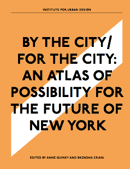
You can't buy this book on Amazon, or from Powells. This unique book is a collection of "schemes & dreams"; ideas from everyday people around the world about how New York City should evolve and grow realized by designers and architects. Kitchen sink ideas include everything from planters hung from the back of billboards to turning unused space in Staten Island ferries into floating museums (with cocktails, of course). The Institute for Urban Design has done a wonderful job of presenting these out-of-the-box ideas in a way that can inspire tactical urbanists and professional planners to think differently.
For the Love of Cities: The Love Affair Between People and their Places
By Peter Kageyama Creative Cities Productions, 242 pages 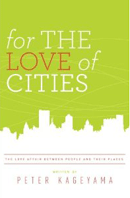
In the introduction to this fast moving 215-page book, Kageyama asserts that when considering the improvement of cities, the pursuit of livability, no matter how it is defined or measured, is not enough. He writes: "Livable is good-it's a fine aspiration that we have yet to achieve on any large scale. But I think we can do better. Instead of merely livable, I think we need to start thinking about how we make our cities more lovable. When we love something, we cherish it; we protect it; we do extraordinary things for it." While the book covers a range of relevant topics- the importance of walkability, openness, and increasing public engagement through social media-the book focuses mostly on "co-creators" and how they make cities more lovable. According to Kageyama successful cities consistently attract and retain an evolving community of co-creators – those committed entrepreneurs, artists, performers, organizers, and concerned citizens-who "make things, and make things happen."
Instant City: Life and Death in Karachi
By Steve Inskeep The Penguin Press HC, 304 pages
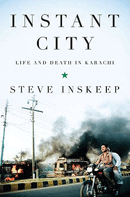 Steve Inskeep, who's voice is instantly familiar to any NPR listener, brings us this fascinating look at the "instant city" of Karachi, Pakistan. He calls it an "instant city" because it, like many urban areas around the world, has seen an epic migration from the country to the city, going from half a million in the 40s to 13 million today. Opening up the book with a bombing in Karachi, Inskeep peels away at the traditional reasons of why the bombing occurred, like a terrorist attack, and finds more theories that point to the areas valuable real estate. The book delves deeply into the city's urban planning issues like casino developments, housing projects, squatting, road building, and land use squabbles, not to mention the deeper divisions along religious and ethnic lines. Throughout, Inskeep delivers a thoughtful and powerful story mixed with an analytical eye at the built environment.
Steve Inskeep, who's voice is instantly familiar to any NPR listener, brings us this fascinating look at the "instant city" of Karachi, Pakistan. He calls it an "instant city" because it, like many urban areas around the world, has seen an epic migration from the country to the city, going from half a million in the 40s to 13 million today. Opening up the book with a bombing in Karachi, Inskeep peels away at the traditional reasons of why the bombing occurred, like a terrorist attack, and finds more theories that point to the areas valuable real estate. The book delves deeply into the city's urban planning issues like casino developments, housing projects, squatting, road building, and land use squabbles, not to mention the deeper divisions along religious and ethnic lines. Throughout, Inskeep delivers a thoughtful and powerful story mixed with an analytical eye at the built environment.
One Less Car: Bicycling and the Politics of Automobility
By Zack Furness Temple University Press, 344 pages
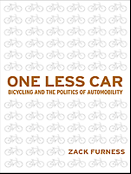 Out of the pile of bicycle-centric books that landed in our office, One Less Car by Zack Furness jumped to the top. Furness, a cultural studies professor at Columbia, looks at what it means to be part of the 1% - in this case, the percentage of the total U.S. population that ride bicycles for transportation. The book is an engaging look at the cultural and political significance of the bicycle through history, exploring the little known story of groups like Ciclisti Rosso, the "Red Cyclists", a 1912 socialist group that were antecedents to today's Critical Mass. Furness looks at activist movements that have popped up across the country, whether it is DIY bike movements or government supported awareness campaigns. The author occasionally indulges a little too much in academic jargon, but on the whole he presents a comprehensive and informative look at the meaning behind the fixies, cruisers and road bikes of today.
Out of the pile of bicycle-centric books that landed in our office, One Less Car by Zack Furness jumped to the top. Furness, a cultural studies professor at Columbia, looks at what it means to be part of the 1% - in this case, the percentage of the total U.S. population that ride bicycles for transportation. The book is an engaging look at the cultural and political significance of the bicycle through history, exploring the little known story of groups like Ciclisti Rosso, the "Red Cyclists", a 1912 socialist group that were antecedents to today's Critical Mass. Furness looks at activist movements that have popped up across the country, whether it is DIY bike movements or government supported awareness campaigns. The author occasionally indulges a little too much in academic jargon, but on the whole he presents a comprehensive and informative look at the meaning behind the fixies, cruisers and road bikes of today.
Pocket Neighborhoods: Creating Small-Scale Community in a Large-Scale World
by Ross Chapin Taunton Press, 224 pages
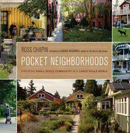 A coffee table book with a mission, Pocket Neighborhoods presents a focused look at a unique sort of development which the author defines as "clusters of homes gathered around a landscaped common area." These "pocket neighborhoods" are a traditional model that was lost in the suburban shift, and today is spurring a new movement towards increased togetherness and a sense of community. Chapin writes with an approachability that invites laypeople in, but also includes design tips and lots of lovely pictures to inspire professionals. He brings his own expertise in designing pocket neighborhoods to illustrate the lessons they've learned through trial and error. Chapin's narrow focus on this under-explored method of creating community makes this an essential read.
A coffee table book with a mission, Pocket Neighborhoods presents a focused look at a unique sort of development which the author defines as "clusters of homes gathered around a landscaped common area." These "pocket neighborhoods" are a traditional model that was lost in the suburban shift, and today is spurring a new movement towards increased togetherness and a sense of community. Chapin writes with an approachability that invites laypeople in, but also includes design tips and lots of lovely pictures to inspire professionals. He brings his own expertise in designing pocket neighborhoods to illustrate the lessons they've learned through trial and error. Chapin's narrow focus on this under-explored method of creating community makes this an essential read.
Triumph of the City: How Our Greatest Invention Makes Us Richer, Smarter, Greener, Healthier, and Happier
By Edward Glaeser The Penguin Press HC, 352 Pages
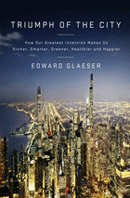 In a previous era, Harvard professor Ed Glaeser, bedecked in his trademark three-piece suit, might have been the one of the technocrats out there with his slide rule and transit, "scientifically" deciding just how much of a neighborhood to knock down. But, today, urban planning's very own Don Draper has put quantitative analysis to a far more humane use. If Jane Jacobs wrote from the heart, Glaeser writes decidedly from the head. But he reaches much the same conclusions as Jacobs did: cities are wonderful and, most importantly for Glaeser, cities create value. Much of the data analysis--not to mention the poetic connections between Renaissance art, the Golden Age of Athens, and call centers in Bangalore--is intuitive to contemporary progressive urbanists. True to his conservative manner, Glaeser does not call for radical re-visioning of cities. His arguments imply that everything from historic preservation to urban agriculture to congestion pricing can be valuable only insofar as they support a city's ability to nurture ideas and increase prosperity.
In a previous era, Harvard professor Ed Glaeser, bedecked in his trademark three-piece suit, might have been the one of the technocrats out there with his slide rule and transit, "scientifically" deciding just how much of a neighborhood to knock down. But, today, urban planning's very own Don Draper has put quantitative analysis to a far more humane use. If Jane Jacobs wrote from the heart, Glaeser writes decidedly from the head. But he reaches much the same conclusions as Jacobs did: cities are wonderful and, most importantly for Glaeser, cities create value. Much of the data analysis--not to mention the poetic connections between Renaissance art, the Golden Age of Athens, and call centers in Bangalore--is intuitive to contemporary progressive urbanists. True to his conservative manner, Glaeser does not call for radical re-visioning of cities. His arguments imply that everything from historic preservation to urban agriculture to congestion pricing can be valuable only insofar as they support a city's ability to nurture ideas and increase prosperity.
Walking Home: The Life and Lessons of a City Builder
By Ken Greenberg Random House Canada, 400 pages
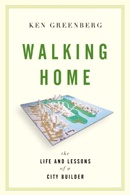 Walking Home is a personal, compelling and persuasive argument for more enlightened city-building, made all the more convincing by the Toronto-based author's 30 years of international experience as an urban designer and architect. At once a memoir, a history of North American urban planning and a manifesto for a more sustainable and humane urban future, Walking Home articulates the urgent need for change while providing his colleagues and interested laypersons alike practical and entertaining guidance for bringing it about.Greenberg argues that, if we are to continue to live in large cities in an era of high energy costs and climate change, then we need to "reclaim the promise of the city" by making our cities places of diversity and adaptability, of density and vibrant public spaces, where nature and the city are integrated, and where we can leave our cars behind and walk among -- and get to know -- our neighbors.
Walking Home is a personal, compelling and persuasive argument for more enlightened city-building, made all the more convincing by the Toronto-based author's 30 years of international experience as an urban designer and architect. At once a memoir, a history of North American urban planning and a manifesto for a more sustainable and humane urban future, Walking Home articulates the urgent need for change while providing his colleagues and interested laypersons alike practical and entertaining guidance for bringing it about.Greenberg argues that, if we are to continue to live in large cities in an era of high energy costs and climate change, then we need to "reclaim the promise of the city" by making our cities places of diversity and adaptability, of density and vibrant public spaces, where nature and the city are integrated, and where we can leave our cars behind and walk among -- and get to know -- our neighbors.
Other Noteworthy Titles
All Over the Map: Writing on Buildings and Cities
By Michael Sorkin Verso, 320 pages
Michael Sorkin passionately disburses his thoughts on large-scale architecture in the appropriately titled All Over the Map. His stream of consciousness approach to a panoply of topics ranging from 1960s intellectual critique to architectural responses to 9/11 is compellingly honest. In particular, his scathing attacks on contemporaries and competitors are rabidly funny, of which the critique of Phillip Johnson's work and essence on page three is a highlight. The work is opinionated, but explanatory, and the breadth of topics keeps Sorkin on his toes and ensures that he never becomes didactic or overly moralistic. The vitality of his interest in so many human interactions and productions will make a bird watcher of even the most distracted reader.
The Economics of Place: The Value of Building Communities Around People
Edited by Colleen Layton, Tawny Pruitt and Kim Cekola Michigan Municipal League, 175 pages
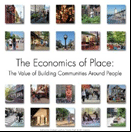 The Economics of Place maps out an arts-driven regeneration plan for Michigan like a modern day Magna Carta, punctuated by testimonials from professionals in the field. The collection of essays encourages the reader to avoid externalizing 'place' as something separate from our core identity. Instead we should give more consideration to how places make us happier or healthier, and how this in turn drives economic activity. In praising the knowledge economy, mixed-use urban infill, benevolent immigrants, and social and cultural entrepreneurs, the work occasionally becomes proselytizing. But the book is brought back down to earth by its specific focus on the future of Michigan, which adds context to all the theory. The Michigan Municipal League provides an array problems and solutions, but also excellently outlines the principal obstacles to these development patterns. The concluding chapters contain a considered examination of counterproductive federal transit and housing policy that undermine planners' work to increase density and promote urban centers. While historically curious, the empirical breakdown of these laws and their effects set out specific courses of action for practitioners to follow.
The Economics of Place maps out an arts-driven regeneration plan for Michigan like a modern day Magna Carta, punctuated by testimonials from professionals in the field. The collection of essays encourages the reader to avoid externalizing 'place' as something separate from our core identity. Instead we should give more consideration to how places make us happier or healthier, and how this in turn drives economic activity. In praising the knowledge economy, mixed-use urban infill, benevolent immigrants, and social and cultural entrepreneurs, the work occasionally becomes proselytizing. But the book is brought back down to earth by its specific focus on the future of Michigan, which adds context to all the theory. The Michigan Municipal League provides an array problems and solutions, but also excellently outlines the principal obstacles to these development patterns. The concluding chapters contain a considered examination of counterproductive federal transit and housing policy that undermine planners' work to increase density and promote urban centers. While historically curious, the empirical breakdown of these laws and their effects set out specific courses of action for practitioners to follow.
Railroad Stations: The Buildings That Linked the Nation
By David Naylor W. W. Norton & Company, 336 pages
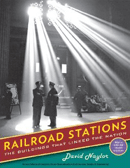 America's railroads are important reference points for the centrality they have provided to urban communities for more than a century. Beyond this, they played a key role in American historical development, following Benjamin Franklin's Postal Service and Preceding the Interstate age. David Naylor, author of this beautiful picture book, writes that "[d]ecisions about where to lay tracks and build stations charted the nation's rise, affected the course of the Civil War and enabled us to settle the western territories." Naylor's visual compendium contains over 600 beautiful photographs of stations from around the country, designed in a variety of revivalist styles. The Midwestern stations in particular will provide a nostalgia to holiday travelers weary of the security laced monotony and congestion of today's airport terminals.
America's railroads are important reference points for the centrality they have provided to urban communities for more than a century. Beyond this, they played a key role in American historical development, following Benjamin Franklin's Postal Service and Preceding the Interstate age. David Naylor, author of this beautiful picture book, writes that "[d]ecisions about where to lay tracks and build stations charted the nation's rise, affected the course of the Civil War and enabled us to settle the western territories." Naylor's visual compendium contains over 600 beautiful photographs of stations from around the country, designed in a variety of revivalist styles. The Midwestern stations in particular will provide a nostalgia to holiday travelers weary of the security laced monotony and congestion of today's airport terminals.Walt and the Promise of Progress City
By Sam Gennawey Norton, 272 pages
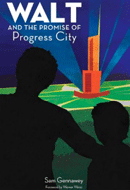 Just before his death, Walt Disney (the man) had a bold idea. In the center of his Orlando theme park project, he would build a city like no other, an "Experimental Prototype Community of Tomorrow", or EPCOT. Sam Gennawey, an urban planner by trade, digs up the history of Walt's bold idea in Walt and the Promise of Progress City, tracking down Disney's dealings with Victor Gruen and Robert Moses that inspired his ideas. Gennawey says that Disney, way back in 1964, was interested in creating human-scaled communities and getting people out of their cars. Gennawey uses the planning concepts of today developed by Christopher Alexander and Andres Duany as a way to look at the EPCOT that might have been, and at Disneyland itself. A highly entertaining read.
Just before his death, Walt Disney (the man) had a bold idea. In the center of his Orlando theme park project, he would build a city like no other, an "Experimental Prototype Community of Tomorrow", or EPCOT. Sam Gennawey, an urban planner by trade, digs up the history of Walt's bold idea in Walt and the Promise of Progress City, tracking down Disney's dealings with Victor Gruen and Robert Moses that inspired his ideas. Gennawey says that Disney, way back in 1964, was interested in creating human-scaled communities and getting people out of their cars. Gennawey uses the planning concepts of today developed by Christopher Alexander and Andres Duany as a way to look at the EPCOT that might have been, and at Disneyland itself. A highly entertaining read.
Desert Visions and the Making of Phoenix
By Philip VanderMeer[Eds.] University of New Mexico Press, 416 pages
Bird on Fire: Lessons from the World's Least Sustainable City
By Andrew Ross[Eds.] Oxford University Press, 312 pages

 When not one, but two books crossed our desks on the subject of Phoenix, we were intrigued. Together, they make an interesting double dip into the "world's least sustainable city." Desert Visions is the heftier tome, tackling the history of the city from 1860 onwards, while Bird on Fireis focused more on Phoenix today as the proto-low density American city. Can the mixed-use, high-density model have any effect on a city like Phoenix? And if not, how do we move our sprawling cities forward? Ross does an eloquent job of summarizing the politics of the 21st century, while VanderMeer basically ends at the 20th. While the dense details of both books may only interest Phoenicians, together these books paint an accurate portrait of the problems facing many U.S. cities today.
When not one, but two books crossed our desks on the subject of Phoenix, we were intrigued. Together, they make an interesting double dip into the "world's least sustainable city." Desert Visions is the heftier tome, tackling the history of the city from 1860 onwards, while Bird on Fireis focused more on Phoenix today as the proto-low density American city. Can the mixed-use, high-density model have any effect on a city like Phoenix? And if not, how do we move our sprawling cities forward? Ross does an eloquent job of summarizing the politics of the 21st century, while VanderMeer basically ends at the 20th. While the dense details of both books may only interest Phoenicians, together these books paint an accurate portrait of the problems facing many U.S. cities today.
Buy Desert Visions Buy Bird on Fire

Plan to Potentially Remove Downtown Milwaukee’s Interstate Faces Public Scrutiny
The public is weighing in on a suite of options for repairing, replacing, or removing Interstate 794 in downtown Milwaukee.

‘Forward Together’ Bus System Redesign Rolling Out in Portland
Portland is redesigning its bus system to respond to the changing patterns of the post-pandemic world—with twin goals of increasing ridership and improving equity.

Can New York City Go Green Without Renewable Rikers?
New York City’s bold proposal to close the jail on Rikers Island and replace it with green infrastructure is in jeopardy. Will this compromise the city’s ambitious climate goals?

700-Acre Master-Planned Community Planned in Utah
A massive development plan is taking shape for lakefront property in Vineyard, Utah—on the site of a former U.S. Steel Geneva Works facility.

More Cities Ponder the End of Drive-Thrus
Drive-thru fast food restaurants might be a staple of American life, but several U.S. cities are actively considering prohibiting the development of new drive-thrus for the benefit of traffic safety, air quality, and congestion.

Air Pollution World’s Worst Public Health Threat, Report Says
Air pollution is more likely to take years life off the lifespan of the average human than any other external factor, according to a recent report out of the University of Chicago.
Placer County
City of Morganton
HUD's Office of Policy Development and Research
Dongguan Binhaiwan Bay Area Management Committee
City of Waukesha, WI
Los Angeles County Metropolitan Transportation Authority
Indiana Borough
Write for Planetizen
Urban Design for Planners 1: Software Tools
This six-course series explores essential urban design concepts using open source software and equips planners with the tools they need to participate fully in the urban design process.
Planning for Universal Design
Learn the tools for implementing Universal Design in planning regulations.
